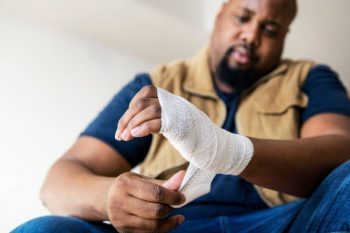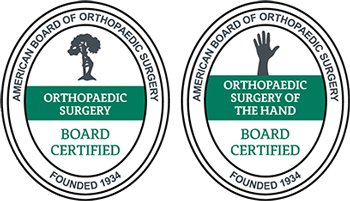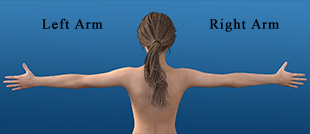Hand Injuries & Conditions

Made up of 27 bones, 27 joints, 34 muscles, and over 100 ligaments and tendons, the hand is a very intricate – and oftentimes delicate – extremity of the human body. Because of this, hand injuries are relatively common and can result from a wide variety causes including falls, cuts, burns, animal bites, overuse, infection, and more. Some hand injuries and conditions can be treated or managed at home, while others require a doctor to properly tend to. Because of the ranging severity of hand injuries and conditions, it’s important to have access to proper information on each condition so you can seek the best treatment possible.
Below are some of the most common hand injuries and conditions we see at The Hand and Wrist Institute. For more details and information on each condition – including causes, symptoms, when to see a doctor, and surgical and non-surgical treatment options – please visit the links below.
- Arthritis of the Hand
- Basal Thumb Arthritis
- Boutonniere Finger
- Boxers Fracture
- Burns of the Hand
- Digital Mucoid Cysts
- Dupuytren’s Contracture
- Extensor Tendon Injuries
- Finger Joint Injuries
- Flexor Tendon Injuries
- Gamekeeper’s Thumb
- Glomus Tumor
- Hand Fractures
- Hand Infections
- Hand Numbness
- Hand Tumors
- Mallet Finger
- Metacarpal Fractures
- Mommy Thumb
- Nail bed Injuries
- Nail Infection
- Nerve Injuries of the Hand
- Rheumatoid Arthritis
- Sagittal Band Tear
- Swan Neck Deformity
- Trigger Finger
- Vascular Disorders
Sprains and Strains
Sprains can happen when you overstretch or tear the ligaments in your hands or wrists. They affect the muscles or tendons and are some of the most common hand injuries in the workplace, occurring from overuse, trauma, or repetitive motion. Symptoms include pain, swelling, and difficulty moving the affected joint. To treat a sprain or a strain, we suggest rest, ice, compression, and elevation, also known as the RICE method. We may also prescribe anti-inflammatory medication or physical therapy.
Fractures
You can fracture your hands, fingers, or wrists if you have a fall or an accident, such as while playing sports. Symptoms include pain, swelling, deformity, and limited range of motion. The treatment varies depending on the severity of the fracture. We may suggest using a splint and a cast for less severe fractures, while for more complex fractures, surgery may be needed to correct the alignment.
Tendon Injuries
Tendon injuries include conditions such as tendonitis, which is where the tendons become inflamed. They can also include more severe injuries, including tendon ruptures. These injuries can occur from overuse, trauma, or inflammation, with symptoms including pain, swelling, and difficulty moving the joint. To treat a tendon injury, we suggest rest, joint immobilization, and physical therapy. In severe cases, we may recommend surgery to repair and restore function.
Dislocations
Dislocations can occur during a sudden injury or trauma that forces the bones out of alignment. Symptoms include severe pain, deformity, and difficulty moving the affected joint. In some cases, dislocations may damage the nerves or blood vessels. To treat these injuries, we gently reposition the displaced bones in a process known as reduction. We then use a splint or cast to immobilize the joint and encourage it to heal. We may recommend physical therapy or surgery in severe cases.
Repetitive Strain Injuries
Repetitive strain injuries (RSIs) develop from overuse of the hand. carpal tunnel syndrome is the most common example. This occurs when the median nerve in the wrist becomes compressed due to trauma or repetitive motion, such as typing. RSIs cause pain, numbness, tingling, and weakness in the hand or fingers. We use wrist splints, anti-inflammatory medications, and corticosteroid injections to treat this condition, though severe cases might require surgery.
Cuts and Lacerations
Cuts and lacerations are common hand injuries. For example, you may cut yourself with a kitchen knife while preparing food. Symptoms include bleeding, pain, swelling, and potential damage to the underlying structures. To treat a cut or laceration, we clean the wound and apply pressure to control the bleeding. We may give you stitches for deep or gaping cuts. Tetanus shots may be required in some cases.
Burns
Burns occur when your hand comes into contact with a hot surface, flame, corrosive chemical, or electrical source. Symptoms range from pain and redness to blistering and severe tissue damage. Treatment varies depending on the severity of your burn. We start by cooling the burn and applying sterile dressings, though you may need surgery in severe cases.
Tips for Avoiding Common Hand Injuries
Let’s explore some practical tips for avoiding common hand injuries.
Invest in the Right Equipment
Using the right tools and equipment can help prevent accidents and injuries. This is important during work or hobbies, such as gardening or woodworking, which are some of the biggest causes of hand injury. Choose high-quality tools with ergonomic handles to reduce hand strain, and use safety gear when appropriate, such as gloves, wrist guards, and safety glasses, especially when playing sports.
Stretch Your Muscles
Regularly stretching your hands and wrists can help prevent overuse injuries, such as carpal tunnel syndrome and tendonitis. There are many exercises you can do to improve flexibility in your hands and wrists, including extending your arms in front of you and circling your wrists slowly in both directions. You can also practice hand squeezes with a stress ball.
Practice Strength Training
While stretching improves flexibility and joint mobility, strength training builds muscle strength. Both forms of exercise are important for preventing common hand injuries. Aim to incorporate a few strength training exercises into your daily routine. Grip-strengthening exercises performed using hand grippers can be beneficial. You can also use resistance bands or light dumbbells.
Consider Ergonomics
An ergonomic setup can reduce the risk of repetitive strain injuries. Adjust your chair, keyboard, and mouse to ensure a comfortable and neutral hand position while typing or using a computer. Take hourly breaks to stretch and rest your hands — these brief pauses can help give your body a rest.
Avoid Overexerting Yourself
Listen to your body, and avoid overexerting yourself. Pushing yourself too hard can increase the risk of strain and fatigue. If a task feels too demanding, consider asking for help or using tools or equipment to make it easier. Split large or strenuous tasks into smaller, more manageable steps. Stay hydrated, eat nutritious meals and snacks, and ensure that you get enough rest and sleep to keep your energy levels up.
Be Mindful
Be cautious when handling heavy items to prevent strains and sprains. When lifting heavy objects, aim to distribute the weight evenly across both hands. Bend your knees and keep your back straight to minimize strain on your hands and wrists. Be careful when using sharp or hot objects, and pay attention to the task at hand.
Take Steps To Prevent Falls
Be mindful of your surroundings to prevent hand injuries from falls. Use handrails, wear shoes with good traction, and exercise care on slippery surfaces. Keep walkways and work areas free from clutter, and use good lighting so you can see where you’re going.
Go for Regular Check-Ups
Have regular check-ups if you have an underlying health condition that affects your hands, such as arthritis. Follow your health care provider’s recommendations for managing and preventing common hand injuries.
When To Seek Medical Attention
If you’re experiencing severe pain, bleeding, numbness, tingling, or swelling in your hands, we recommend seeking medical care. When in doubt, it’s always better to be safe. If you think you might need medical attention, contact our Dallas hand surgeons at the Hand and Wrist Institute. We can provide a proper diagnosis and treatment plan to restore function and promote healing.
























